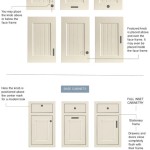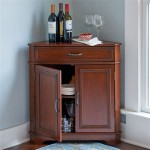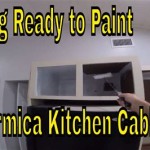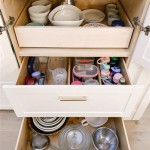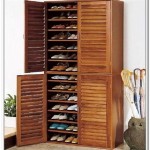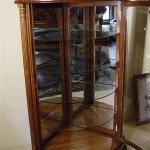Kitchen Cabinet Hardware Placement Guide
Choosing the right kitchen cabinet hardware can significantly enhance the aesthetic appeal and functionality of a kitchen. However, the placement of this hardware is equally crucial. Incorrect placement can lead to difficulties in cabinet operation and detract from the overall design. This guide provides a comprehensive overview of recommended hardware placement practices for various cabinet styles and configurations.
Knobs vs. Pulls: The choice between knobs and pulls often depends on the size and style of the cabinet door or drawer. Knobs are generally suitable for smaller drawers and cabinet doors, offering a simple, clean look. Pulls are better suited for larger drawers and heavier doors, providing a more comfortable grip and easier operation. Functionality should be the primary consideration when making this decision.
Standard Drawer Hardware Placement: For drawers, hardware is typically centered horizontally. Vertically, placement depends on the drawer height. On smaller drawers, the center of the knob or pull is generally positioned halfway between the top edge and the center of the drawer. For taller drawers, placement slightly above the center line is often preferred for easier access.
Upper Cabinet Door Hardware Placement: For upper cabinets, usability and accessibility are key. Placement depends on the style of the door and the desired aesthetic. On standard framed cabinets, the hardware is typically placed on the opposite corner from the hinges, 2 to 3 inches from the bottom and side edges. This placement allows for a natural hand position when opening the cabinet.
Lower Cabinet Door Hardware Placement: Lower cabinets generally follow similar placement principles as upper cabinets, but with some variations. Hardware is placed on the opposite corner from the hinges, 2 to 3 inches from the top and side edges. This placement allows for easy access while minimizing the risk of bumping into the hardware while standing at the counter.
Considerations for Inset Cabinets: Inset cabinets, where the door sits flush within the frame, require specific attention to hardware placement. Hardware should be positioned to avoid interference with the cabinet frame when opening and closing. Careful measurement and planning are essential to ensure proper clearance.
Hardware Placement for Corner Cabinets: Corner cabinets present unique challenges due to their angled configuration. For blind corner cabinets, hardware is placed near the outer edge of the door, allowing for easy access to the cabinet contents. For corner cabinets with two doors, hardware is typically placed on each door, following the standard placement guidelines for upper or lower cabinets, depending on the cabinet's position.
Hardware Placement on Tall Cabinets and Pantry Doors: Tall cabinets and pantry doors often benefit from the use of pulls due to their size and weight. Placement depends on the specific design and the number of doors. For single doors, pulls are typically centered vertically. For double doors, pulls are placed vertically on each door, ensuring symmetrical placement.
Special Considerations for Decorative Hardware: Oversized or uniquely shaped hardware may require adjustments to standard placement guidelines. The primary focus should remain on functionality, but aesthetic considerations also play a role. It’s important to ensure that the hardware does not interfere with the cabinet operation and that it complements the overall kitchen design.
Measuring and Marking for Hardware Installation: Precise measurements are crucial for accurate hardware installation. Templates are often provided with the hardware and can simplify the process. Carefully mark the desired locations on the doors and drawers before drilling to ensure proper alignment and avoid costly mistakes. Double-checking measurements is always recommended.
Factors Influencing Hardware Placement Decisions: Several factors influence the final hardware placement decision. These include the style of the kitchen, the type of cabinets, the size and shape of the hardware, and personal preferences. Considering these factors in conjunction with the recommended placement guidelines will result in a functional and aesthetically pleasing outcome.
The Importance of Consistency in Hardware Placement: Maintaining consistency in hardware placement across all cabinets and drawers is essential for a cohesive and professional look. This includes consistent spacing from edges and consistent vertical alignment. Attention to detail in this area contributes significantly to the overall visual appeal of the kitchen.
Adapting Guidelines to Specific Cabinet Designs: While these guidelines provide a solid foundation, it’s important to recognize that specific cabinet designs may require adjustments. Consulting with a professional cabinet installer or designer can provide valuable insights and ensure optimal hardware placement for unique or complex cabinet configurations.
Utilizing Templates and Guides for Accurate Placement: Templates and guides are invaluable tools for achieving accurate and consistent hardware placement. These tools simplify the marking process and minimize the risk of errors, particularly when dealing with multiple cabinets and drawers. Using these resources is highly recommended for both DIY enthusiasts and professional installers.
Evaluating Hardware Placement After Installation: After installing the hardware, it's important to evaluate its functionality and aesthetic appeal. Open and close each door and drawer to ensure smooth operation and check for any interference. Step back and assess the overall look to confirm that the hardware placement complements the kitchen design.

Cabinet Hardware Placement Guide

The Ultimate Guide For Cabinet Hardware Placement And Sizing Kitchen Inspiration Design

Design 101 Cabinet Hardware Placement Lark Linen

Cabinet Hardware Placement Guide

The Ultimate Guide For Cabinet Hardware Placement And Sizing Kitchen Remodel

Hardware Guide

Guide For Hardware Positioning Mockett Cabinet Placement Kitchen

How To Install Cabinet Handles Straight Without Losing Your Mind

Hardware Guide

Easy Cabinet Hardware Placement Guide Bloom And Babe
Related Posts

